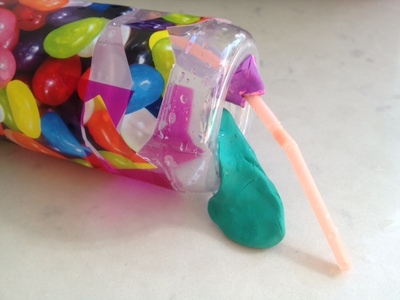These fizzing bottle boats may not break any speed records but are fun to make and play with. Older kids can enjoy learning about simple chemical reactions and forces.

Materials
- Small plastic bottle
- Patterned contact paper (sticky back plastic) to decorate
- Skewer
- Modelling clay
- Bendy drinking straw
- Bicarbonate of soda
- Citric acid powder
How to Make Fizzing Bottle Boats
- Cut shapes out of coloured contact paper (sticky back plastic) and stick on the bottle to decorate.


- Make a hole just large enough to fit a drinking straw in the bottom of the bottle, between the centre and the edge of the circle.
- Cut the end off the long part of a drinking straw.
- Using the modelling clay, make a ring to go around the drinking straw and a rudder shape (see the photo below).

- Insert the drinking straw into the hole in the bottom of the bottle and bend the flexy part of the straw so that the tip of the straw will sit under water when it floats. Press the modelling clay ring to seal any gaps in the hole.
- Press the modelling clay rudder onto the bottom of the bottle (see the photo below).

- Mix 1 part citric acid to 3 parts bicarbonate of soda in a dish. Be careful not to get any water on the powder mix as it will start the reaction off.

- The bottle boat is now ready to go. Head to where you want to launch the boat for the final assembly. You could try a swimming pool, bath tub or paddling pool.
- Scoop around 3 tablespoons of the acid/soda powder mix into the bottle boat. A funnel can make this easier.

- Add a centimetre or so of water into the bottle then screw the cap on and launch the boat, with the tip of straw poking into the pool. The chemical reaction starts quickly so you need to do this really fast.
-
Watch the fizzing reaction and see bubbles coming out of the straw through the water. The bottle boat should propel slowly forwards as the gas escapes.

How does it work?
When water is added to the bottle, the alkaline bicarbonate of soda reacts with the citric acid forming sodium citrate, water and carbon dioxide. The carbon dioxide gas produced escapes through the drinking straw and bubbles through the pool water. The boat is propelled in the opposite direction.

















